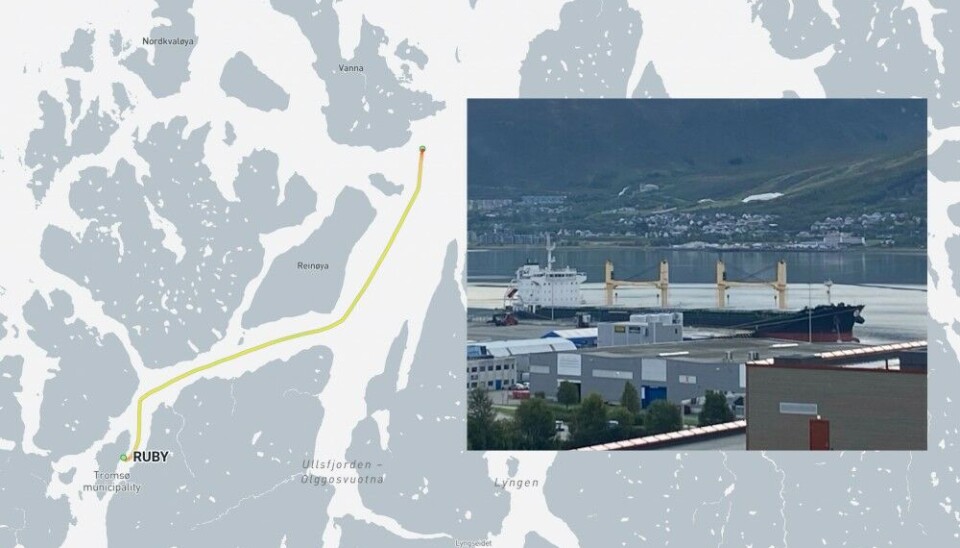
Trouble vessel has departed Tromsø, but future uncertain
Loaded with 20,000 tons of ammonium nitrate, the Ruby is now at anchor near Vannøya north of Tromsø with slight damage to propeller, hull and rudder.
Concern spread in Tromsø as it became known that the large bulk carrier docked to the industrial port was loaded with potentially dangerous ammonium nitrate. Although the local fire department assured to the Barents Observer that no immediate danger existed, others were worried.
By the end of the day Tromsø police decided to order the ship to leave the city.
Assisted by two tugs, the Ruby left port around 2 a.m. on the night to September 4. Her current position at anchor is some 30 nm to the north, away from inhabited areas.
The ship came from Kandalaksha on the south coast of the Kola Peninsula and was heading towards Las Palmas. Outside Tromsø, the captain asked Norwegian authorities for permission to seek shelter as stormy weather troubled the voyage.
Permission was granted and Ruby stayed in the waters near Vannøya for several days before sailing to port in Tromsø. The captain informed about damage to the hull, propeller and rudder. Repair on such a large vessel with dangerous cargo, however, is not a kind of work to be done in close distance from northern Norway’s largest hospital, the university campus and hundreds of private homes, all in a radius of a kilometer from the Breivika port facilities where Ruby docked on Monday.
What now will happen with the Maltese flagged vessel and its cargo is highly uncertain. A continued sailing along the coast of Norway, via the English Channel, the Bay of Biscay and the Atlantic Ocean down to the Canary is not a voyage anyone will like to do in autumn with damage to vital gear like the propeller and the rudder.
If repair requires docking of the 183 meters long vessel anywhere in Norway, the 20,000 tons of ammonium nitrate would most likely have to be temporarily unloaded. Having the Beirut disaster in mind, it could be hard to find a shipyard willing to do the job. Sailing back to Russia seems unlikely as neither the boat nor the cargo is Russian.
There are many questions yet to be answered. For instance; when and where did the damage to the hull happen? Newspaper Nordlys in Tromsø has in detail studied the paths of the vessel’s AIS before and after it asked for refuge on August 26. Nowhere along the route are shallow waters, islands or reefs where the hull could have grounded or touched the bottom.
Unless the damage happened in the Kandalaksha Bay where waters are shallow with many small islands. If so, why didn’t the captain inform Russian port authorities, or maybe he did?
And why did the captain stay at anchor inside Vannøya for several days after the stormy weather ended? Then, why was the voyage towards Las Palmas not continued and instead it was decided to sail to port in Tromsø?
The Barents Observer’s question to the Norwegian Joint Headquarters about their knowledge concerning the cargo when refuge was granted remains unanswered.
The Armed Forces, the police, the Coastal Administration, the municipality of Tromsø, fire brigades, the Directorate for Civil Protection and others involved in emergency preparedness likely have a long list of learning after this incident.
Meanwhile, the Ruby and her potentially explosive cargo is a headache for Norway. 20,000 tons is more than seven times as much ammonium nitrate than the explosion that leveled part of Beirut.
According to Nordlys, there is a crew of 19 onboard, for the most Syrians.
Some previous ship/harbour disasters with ammonium nitrate:
- August 4 2020, Port of Beirut, Lebanon: The explosion caused 218 deaths and 7,000 injuries and destroyed buildings making 300,000 people homeless. Some 2,750 tonnes of ammonium nitrate previously unloaded from a ship went off.
- April 16, 1947, Texas City, USA: The deadliest industrial disaster in U.S. history. 2,300 tons ammonium nitrate in a vessel at port went off. 581 killed and many wounded.
- July 28, 1947, Brest, France: A Norwegian ship loaded with 3,309 tonns of ammonium nitrate caught fire, was towed to port and exploded. 29 deaths and big damage to the port facilities.














